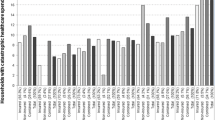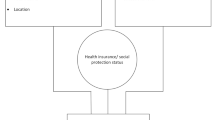Abstract
This study tests whether the low-income population in Bogota not insured under the General Social Security Health System is able to economically handle unexpected health problems or not. It used data from the Health Services Use and Expenditure Study conducted in Colombia in 2001, for which each household recorded its monthly out-of-pocket health expenditure during the year and the household income was measured as the sum of each member’s contribution to the household. Payment capacity or available income and catastrophic health spending were based on the latest methodology proposed by the World Health Organization (WHO) in 2005. A probit model was adjusted to determine the factors that significantly influence the likelihood of a household having catastrophic health spending. The percentage of households with catastrophic health spending in Bogota was 4.9%; incidence was higher in low-income households where none of the members were affiliated to social security, where there had been an in-patient event, and where the heads of household were over 60 years of age. There is no statistical evidence for rejecting the hypothesis under study, which states that low-income households that have no health insurance are more likely to have catastrophic health spending than higher-income households with health insurance.
Similar content being viewed by others
References
Alvis L., Alvis N., de la Hoz F. (2004) Gasto privado en salud de los hogares de Cartagena de Indias. Revista de Salud Pública 9(1): 11–15
Arrow K. J. (1963) Uncertainty and the welfare economics of medical care. The American Economic Review 53(5): 941–973
Berki S. (1963) A look at catastrophic medical expenses and the poor. Health affairs 5(4): 138–145
Cendex—Centro de Proyectos para el Desarrollo: (2001) Encuesta de Usos y Gastos en Salud. BID—Banco Interamericano de Desarrollo, Colombia. Financiación
Corcho, A.E., Castilla, M., & Acosta, N. (2000). Narrativa sobre la Reforma del Sistema de Salud en Colombia. Núcleo de Acopio, Apoyo y Difusión de las Iniciativas de Reforma, Instituto de Salud Pública.
Cruz C., Luna G. A., Morales R., Coello C. G. (2006) Gasto catastrófico en salud y elasticidades ingreso por tipo de gasto en servicios de salud en México. Bienestar y Política Social 2(1): 51–73
Friedman B. (1974) Risk aversion and the consumer choice of health insurance options. The Review of Economics and Statistics 56: 209–214
Hernández J., Avila L., Valencia A., Poblano O. (2008) Evaluación Inicial del Seguro Popular sobre el Gasto Catastrófico en Salud en México. Revista de Salud Pública de México 10(1): 18–32
Inter-American Development Bank: (2006) Colombia, Expansion of the program for the reorganization, redesign and modernization of health service networks. Loan Proposal, PIC, CO-L1017
Knaul F., Arreola H., Méndez O. (2005) Protección financiera en salud: México, 1992 a 2004. Revista de Salud Pública de México 47(6): 430–439
Knaul, F., Arreola, H., Méndez, O., & Miranda, M. (2006). Preventing impoverishment promoting equity and protecting households from financial crisis: Universal Health Insurance through Institutional Reform in Mexico. Working Paper Series, Innovations in Health Financing.
Knaul F., Arreola H., Méndez O., Bryson C., Barofsky J., Maguire R., Miranda M., Sesma S. (2007) Las evidencias benefician al sistema de salud: reforma para remediar el gasto catastrófico y empobrecedor en salud en México. Salud Pública de México 49: S70–S87
Limwattananon S., Tangcharoensathien V., Prakongsai P. (2007) Catastrophic and poverty impacts of health payments: results from national household survey in Thailand. Bulletin of the World Health Organization 85: 600–606
Manning W. G., Newhouse J. P., Duan N. et al (1987) Health insurance and the demand for medical care: evidence from the randomized experiment. American Economic Review 77(3): 251–277
Merlis, M. (2002). Family out-of-pocket spending for health services: A continuing source of financial insecurity. The Commonwealth Fund.
Mora H. (2000) Riesgo del aseguramiento en el sistema de salud en Colombia en 1997. Serie Financiamiento del desarrollo, N o 95. CEPAL, Mayo, Santiago
O’Donnell, O., van Doorslaer, E., & RananEliya, R., et al. (2005). Explaining the incidence of catastrophic expenditures on health care: Comparative evidence from Asia. EQUITAP Project, working paper #5. Colombo: Erasmus University, Rotterdam and IPS.
O’Donnell, O., van Doorslaer, E., Wagstaff, A., & Lindelow, M. (2008). Catastrophic payments for health care. Chap. 18 in: Analyzing health equity using household survey data: A guide to techniques and their implementation. Washington, DC: The World Bank, WBI Learning Resources Series
O’Meara G., Ruiz F., Amaya J. L. (2003) Impacto del aseguramiento sobre uso y gasto en salud en Colombia. CEJA, Bogotá
Pérez R., Sesma S., Puentes E. (2005) Gastos catastróficos por motivos de salud en México: estudio comparativo por grado de marginación. Revista de Salud Pública de México (suplemento) 47(1): S47–S53
Perticara, M. (2008). Incidencia de los gastos de bolsillo en salud en siete países latinoamericanos. CEPAL, Serie Políticas Sociales, No.141, Santiago de Chile.
Ruiz, F., Amaya, J. L., & Venegas, S. (2006). Impacto del aseguramiento sobre uso y gasto en salud en Colombia (pp. 3–18).
Sesma S., Pérez R., Gómez O. (2004) Síntesis Ejecutiva: Magnitud y origen de los gastos catastróficos por motivos de salud por entidad federativa: México 2002-2003. Secretaría de Salud de México, México, DF
Sesma S., Pérez R., Sosa C., Gómez O. (2005) Gastos catastróficos por motivos de salud en México: magnitud, distribución y determinantes. Revista de Salud Pública de México 47(1): S37–S46
Torres A. C., Knaul F. (2003) Determinantes del gasto de bolsillo en salud e implicaciones para el aseguramiento universal en México: 1992-2000. Caleidoscopio de la Salud, México, pp 209–225
Universidad Externado de Colombia. (2001). Búsqueda de menores costos, calidad del empleo e informalidad.Boletín del Observatorio del Mercado de Trabajo No. 3.
van de Ven W. P. M., van Praag B. M. S. (1981) Risk aversion and deductibles in private health insurance: application of an adjusted Tobit model to family health care expenditures. Health, Economics and Health Economics. North-Holland, Amsterdam
van Doorslaer, E., O’Donnell, O., & Rannan, R.P., et al. (2005). Paying out-of-pocket for health care in Asia: Catastrophic and poverty impact. EQUITAP Project: Working Paper #2.
Wagstaff A., van Doorslaer E. (2003) Catastrophe and impoverishment in paying for health care: With applications to Vietnam 1993–1998. Health Economics 12(11): 921–934
Wagstaff, A. (2005). The economic consequences of health shocks. World bank development research group, Policy Research Working Paper 3644, Washington, DC, USA.
Wagstaff A. (2008). Measuring financial protection in health. World bank development research group, Policy Research Working Paper 4554, Washington, DC, USA.
Wooldridge, J. (2002). Econometric analysis of cross section and panel data, MIT Press.
World Health Organization. (2000). Health systems: Improving performance. The World Health Report 2000, Geneva.
Wyszewianski L. (1986a) Financially catastrophic and high cost cases: Definitions, distinctions and their implications for policy formulation. Inquiry 23(4): 382–394
Wyszewianski L. (1986b) Families with catastrophic health care expenditures. Health Services Research 21(5): 617–634
Xu K. (2000) World Health Report 2000. World Health Organization, Geneva, Switzerland
Xu K., Evans D. B., Kawabata K., Zeramdini R., Klavus J., Murray J. L. C. (2003a) Household catastrophic health expenditure: A multicountry analysis. Lancet 362: 111–117
Xu, K., Klavus, J., & Kawabata, K., et al. (2003b). Household health system contributions and capacity to pay: Definitional, empirical, and technical challenges. Chap. 39. In C. J. L. Murray & D. B. Evans, Health systems performance assessment: Debates, methods and empiricism. Geneva:World Health Organization.
Xu, K. (2005). Distribution of health payments and catastrophic expenditures. Methodology. Geneva: WHO–Discussion paper No. 2.
Xu, K., Evans, & D., Aguilar, A.M. (2005). Designing health financing systems to reduce catastrophic health expenditure. Geneva: WHO, Technical Briefs for Policy, Makers No. 2.
Xu K., Evans D. B., Carrin G., Aguilar-Rivera A. M., Musgrove P. et al (2007) Protecting households from catastrophic health spending. Health Aff (Millwood) 26(4): 972–983
Author information
Authors and Affiliations
Corresponding author
Rights and permissions
About this article
Cite this article
Amaya Lara, J.L., Ruiz Gómez, F. Determining factors of catastrophic health spending in Bogota, Colombia. Int J Health Care Finance Econ 11, 83–100 (2011). https://doi.org/10.1007/s10754-011-9089-3
Received:
Accepted:
Published:
Issue Date:
DOI: https://doi.org/10.1007/s10754-011-9089-3




